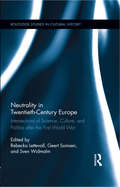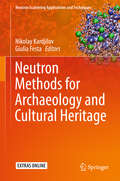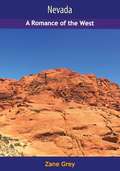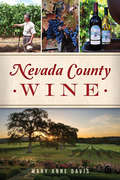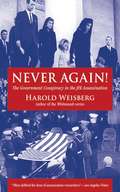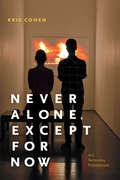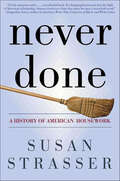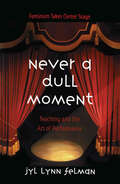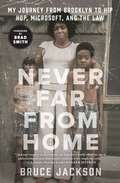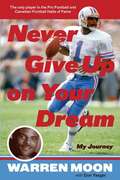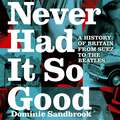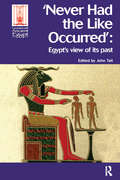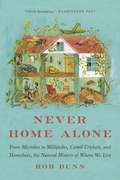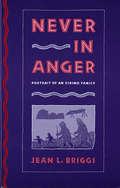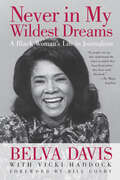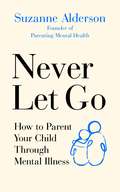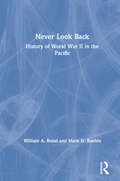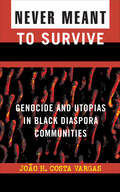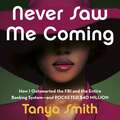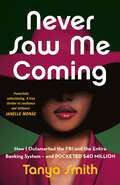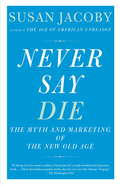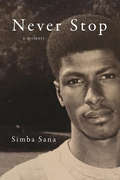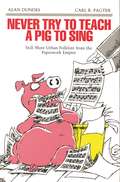- Table View
- List View
Neutrality in Twentieth-Century Europe: Intersections of Science, Culture, and Politics after the First World War (Routledge Studies in Cultural History)
by Rebecka Lettevall Geert Somsen Sven WidmalmWhether in science or in international politics, neutrality has sometimes been promoted, not only as a viable political alternative but as a lofty ideal – in politics by nations proclaiming their peacefulness, in science as an underpinning of epistemology, in journalism and other intellectual pursuits as a foundation of a professional ethos. Time and again scientists and other intellectuals have claimed their endeavors to be neutral, elevated above the world of partisan conflict and power politics. This volume studies the resonances between neutrality in science and culture and neutrality in politics. By analyzing the activities of scientists, intellectuals, and politicians (sometimes overlapping categories) of mostly neutral nations in the First World War and after, it traces how an ideology of neutralism was developed that soon was embraced by international organizations. This book explores how the notion of neutrality has been used and how a neutralist discourse developed in history. None of the contributions take claims of neutrality at face value – some even show how they were made to advance partisan interests. The concept was typically clustered with notions, such as peace, internationalism, objectivity, rationality, and civilization. But its meaning was changeable – varying with professional, ideological, or national context. As such, Neutrality in Twentieth-Century Europe presents a different perspective on the century than the story of the great belligerent powers, and one in which science, culture, and politics are inextricably mixed.
Neutron Methods for Archaeology and Cultural Heritage
by Nikolay Kardjilov Giulia FestaThis book provides an extensive overview of the application of neutron characterization techniques in cultural heritage to a broad audience and will be of interest to both scientists and non-scientists in the field. Archeologists, paleontologists, restaurateurs and conservators, historians and collectors will be fascinated by the wealth of information that can be obtained using neutron techniques, while material scientists and engineers will find details of the experimental techniques and materials properties that can be determined. Neutrons, due to their weak interactions with materials, provide a penetrating, but non-invasive probe of bulk properties. They allow the characterization of the composition and mechanical properties of materials, helping to answer questions related to the dating, the manufacturing process or the state of degradation of artefacts. They allow detailed interrogation of the internal structures of objects that may be otherwise hidden from view. The first section of the book is dedicated to stories describing spectacular discoveries brought about by the use of neutron techniques in a range of applications. The second section covers the experimental techniques in appropriate detail: basic principles, limitations and fields of application.
Neuzuwanderung, sprachliche Bildung und Inklusion: Eine ethnographische Studie im Sekundarschulbereich (Inklusion und Bildung in Migrationsgesellschaften)
by Simone PlögerDie Studie untersucht, wie neu zugewanderte Schüler*innen an einer Hamburger Sekundarschule integrativ, d.h. sowohl in Regelklassen als auch einer Vorbereitungsklasse, beschult werden. Anhand von ethnographischen Daten wird durch Auswertungsmethoden der Reflexiven Grounded Theory aufgezeigt, wie es zu Prozessen der Inklusion und Exklusion durch sprachliche Bildung kommt. Herausforderungen zeigen sich in strukturell-organisationalen Hürden, während sich Chancen durch das inklusive Selbstverständnis der Schule ergeben, die ihren Unterricht an eine diverse Schüler*innenschaft angepasst hat. So hängt die Möglichkeit der Teilhabe am Regelunterricht letztlich vor allem von Faktoren ab, die alle Schüler*innen gleichermaßen und nicht nur neu zugewanderte betreffen.
“Nevada”: A Romance of the West
by Zane GreyTHE BLAZING BESTSELLER BY THE GREATEST NAME IN WESTERN FICTIONFrom the deep wild gorges of the sinister Mogollons in the north, down to the shimmering wastes of the Painted Desert, the rustlers murdered and robbed—while Arizona seethed dangerously. There was only one man who had the guts, the guns and the driving, urgent reason to buck that crew—and his name was Jim Lacy. Wanted by both sides of the law, Jim Lacy, alias Texas Jack, alias Nevada, wanted only one thing—”Dead or alive, clear my name.” “NEVADA” by Zane GreyCLEAR MY NAME!
Nevada County Wine (American Palate)
by Mary Anne DavisNevada County's tumultuous wine history includes several booms and busts, starting in the 1850s when gold prospectors brought the first grapevines in their saddlebags. Economic downturns, prohibition and war all tried to kill the fledgling wine industry, but it hung on thanks to gentleman farmers and members of the mining industry who supplied a thirsty clientele. Today, although the mines have gone quiet, wineries are thriving in the hills of the Gold Country, and the pioneering spirit lives on in their distinctive vintages and growing techniques. Join author Mary Anne Davis as she explores the family vineyards of the California foothills.
Never Again!: The Government Conspiracy in the JFK Assassination
by Harold WeisbergOriginally published in 1995, and in the same classic investigative style of Whitewash and Case Open, Harold Weisberg turns his sharp investigative eye towards the events surrounding the autopsy of John F. Kennedy. Inside Never Again! you'll find: The specific truths regarding the autopsy of John F. Kennedy--truths that have for thirty years been buried, distorted, or ignored not only by the government but also by the national press The blatant errors and calculated deceit of the Journal of the American Medical Association in their 1992 reports on the Kennedy autopsy The path of conspiracy leading from the Navy Hospital in Bethesda through the corridors of the FBI to the Justice Department, into the office of the attorney general and eventually that of the presidentWeisberg argues this case with exclusive regard for the facts. Facts lead to the book's startling new illuminations. Facts provide a compelling narrative filled with intrigue and laced with outrage. Facts reveal the failure of America's institutions to deal effectively with perhaps its most profound national tragedy. In the face of overwhelming facts, Harold Weisberg justly warns us that this must never again happen!
Never Alone, Except for Now: Art, Networks, Populations
by Kris CohenHow is it that one can be connected to a vast worldwide network of other people and places via digital technologies and yet also be completely alone? Kris Cohen tackles this philosophical question in Never Alone, Except for Now by exploring how contemporary technologies are changing group formations and affiliations within social life. He identifies a new form of collectivity that exists between publics, which are built through conscious acts, and populations, which are automatically constructed through the collection of Big Data. Finding traditional liberal concepts of the public sphere and neoliberal ideas of populations inadequate on their own to examine these new forms of sociality, Cohen places familiar features of the web—such as emoticons, trolling, and search engines—in conversation with artworks by Felix Gonzalez-Torres, William Gibson, Sharon Hayes, and Thomson & Craighead to more precisely articulate the affective and aesthetic experiences of living between publics and populations. This liminal experience—caught between existing as a set of data points and as individuals newly empowered to create their own online communities—explains, Cohen contends, how one is simultaneously alone and connected in ways never before possible.
Never Done: A History of American Housework
by Susan StrasserNever Done is the first history of American housework. Beginning with a description of household chores of the nineteenth century--cooking at fireplaces and on cast-iron stoves, laundry done with wash boilers and flatirons, endless water hauling and fire tending--Susan Strasser demonstrates how industrialization transformed the nature of women's work. Lightening some tasks and eliminating the need for others, new commercial processes inexorably altered women's daily lives and relationships--with each other and with the people they served.In this lively and authoritative book, Strasser weaves together the history of material advances and discussions of domestic service, "women's separate sphere" and the impact of advertising, home economics and women's entry into the workforce.Hailed as pathbreaking when originally published, Never Done remains an eye-opening examination of daily life in the American past.
Never Drank the Kool-Aid: Essays
by TouréHis name is Touré--just Touré--and like many of the musicians, athletes, and celebrities he's profiled, he has affected the way that we think about culture in America. He has profiled Eminem, 50 Cent, and Alicia Keys for the cover of Rolling Stone. He's played high-stakes poker with Jay-Z and basketball with Prince and Wynton Marsalis. In Touré's world, Dale Earnhardt, Jr. sits beside Condoleezza Rice who sits beside hip-hop pioneer Tupac Shakur, and all of them are fascinating company.Never Drank the Kool-Aid is the chronicle of Touré's unparalleled journey through the American funhouse called pop culture. Its rooms are filled with creative, arrogant, kind, ordinary, and extraordinary people, most of whom happen to be famous. It is Touré's gift to be able to see through the artifice of their world and understand the genuine motivations behind their achievements--to see who they truly are as people. This is a searingly funny, surprisingly unguarded, and deeply insightful look at a world few of us comprehend.
Never A Dull Moment: Teaching and the Art of Performance
by Jyl Lynn FelmanTeachers are really performers, classrooms are stages, and students the captivated audience. In beautiful prose, Felman invites us to watch her one woman show on the art of performance in today's classrooms. These essays take on the greatest hits of the academy: identity politics, sexual harrassment, academic censorship, and radical pedagogy. Felman's book is a performance not to be missed.
Never Far from Home: My Journey from Brooklyn to Hip Hop, Microsoft, and the Law
by Bruce JacksonMicrosoft&’s associate general counsel shares this story that is &“as nuanced as it is hopeful&” (Hakeem Jeffries, House Minority Leader) about his rise from childhood poverty in pre-gentrified New York City to a stellar career at the top of the technology and music industries in this stirring true story of grit and perseverance. For fans of Indra Nooyi&’s My Life in Full and Viola Davis&’s Finding Me.As an accomplished Microsoft executive, Bruce Jackson handles billions of dollars of commerce as its associate general counsel while he plays a crucial role in the company&’s corporate diversity efforts. But few of his colleagues can understand the weight he carries with him to the office each day. He kept his past hidden from sight as he ascended the corporate ladder but shares it in full for the first time here. Born in Crown Heights, Brooklyn, Jackson moved to Manhattan&’s Amsterdam housing projects as a child, where he had already been falsely accused and arrested for robbery by the age of ten. At the age of fifteen, he witnessed the homicide of his close friend. Taken in by the criminal justice system, seduced by a burgeoning drug trade, and burdened by a fractured, impoverished home life, Jackson stood on the edge of failure. But he was saved by an offer. That offer set him on a better path, off the streets and eventually on the way to Georgetown Law, but not without hard knocks along the way. But even as he racked up professional accomplishments, Jackson is still haunted by the unchanged world outside his office. From public housing to working for Microsoft&’s president, Brad Smith, and its founder, Bill Gates, to advising some of the biggest stars in music, Bruce Jackson&’s Never Far from Home reveals the ups and downs of an incredible journey, how he overcame many obstacles and the valuable lessons learned along the way.
Never Give up on Your Dream: My journey
by Don Yaeger Warren MoonThe inspiring life story of Warren Moon, the "only" player inducted into both the Pro Football and Canadian Football Halls of Fame
Never Had It So Good: A History of Britain from Suez to the Beatles
by Dominic Sandbrook'A rich treasure-chest of a book' ANTHONY HOWARD, Sunday Telegraph'A spectacular history of the sixties' NICK COHEN, Observer'Sandbrook's book is a pleasure to read ... he is a master of the human touch' RICHARD DAVENPORT-HINES, TLS'Rivetingly readable' GODFREY SMITH, Sunday TimesFrom the bloodshed of the Suez Crisis to the giddy heyday of Beatlemania, from the first night of Look Back in Anger to the sensational revelations of the Profumo scandal, British life during the late 1950s and early 1960s seemed more colourful, exciting and controversial than ever. Using a vast array of sources, Dominic Sandbrook tells the story of a society caught between cultural nostalgia and economic optimism. He brings to life the post-war experience for a new generation of readers, in a critically acclaimed debut that will change for ever how we think about the sixties.
Never Had the Like Occurred: Egypt's View of its Past (Encounters with Ancient Egypt)
by John Tait"Never Had the Like Occurred" examines Ancient Egypt's own multifaceted encounters with its past. As Egyptian culture constantly changed and evolved, this book follows a chronological arrangement, from early Egypt to the attitudes of the Coptic population in the Byzantine Period. Within this framework, it asks what access the Egyptians had to information about the past, whether deliberately or accidentally acquired; what use was made of the past; what were the Egyptians attitudes to the past; what sense of past time did the Egyptians have; and what kinds of reverence for the past did they entertain? This is the first book dedicated to the whole range of these themes. It provides an explanatory context for the numerous previous studies that have dealt with particular sets of evidence, particular periods, or particular issues. It provides a case study of how civilizations may view and utilize their past.
Never Home Alone: From Microbes to Millipedes, Camel Crickets, and Honeybees, the Natural History of Where We Live
by Rob DunnA natural history of the wilderness in our homes, from the microbes in our showers to the crickets in our basements <P><P>Even when the floors are sparkling clean and the house seems silent, our domestic domain is wild beyond imagination. In Never Home Alone, biologist Rob Dunn introduces us to the nearly 200,000 species living with us in our own homes, from the Egyptian meal moths in our cupboards and camel crickets in our basements to the lactobacillus lounging on our kitchen counters. You are not alone. <P><P>Yet, as we obsess over sterilizing our homes and separating our spaces from nature, we are unwittingly cultivating an entirely new playground for evolution. These changes are reshaping the organisms that live with us--prompting some to become more dangerous, while undermining those species that benefit our bodies or help us keep more threatening organisms at bay. <P><P>No one who reads this engrossing, revelatory book will look at their homes in the same way again.
Never in Anger: Portrait of an Eskimo Family
by Jean L. BriggsIn the summer of 1963, anthropologist Jean Briggs journeyed to the Canadian Northwest Territories (now Nunavut) to begin a seventeen-month field study of the Utku, a small group of Inuit First Nations people who live at the mouth of the Back River, northwest of Hudson Bay. Living with a family as their “adopted” daughter—sharing their iglu during the winter and pitching her tent next to theirs in the summer—Briggs observed the emotional patterns of the Utku in the context of their daily life. In this perceptive and highly enjoyable volume the author presents a behavioral description of the Utku through a series of vignettes of individuals interacting with members of their family and with their neighbors. Finding herself at times the object of instruction, she describes the training of the child toward achievement of the proper adult personality and the handling of deviations from this desired behavior.
Never in My Wildest Dreams: A Black Woman's Life in Journalism
by Belva Davis Vicki HaddockAs the first black female television journalist in the western United States, Belva Davis overcame the obstacles of racism and sexism, and helped change the face and focus of television news. Now she is sharing the story of her extraordinary life in her poignantly honest memoir, Never in My Wildest Dreams. A reporter for almost five decades, Davis is no stranger to adversity. Born to a fifteen-year-old Louisiana laundress during the Great Depression, and raised in the overcrowded projects of Oakland, California, Davis suffered abuse, battled rejection, and persevered to achieve a career beyond her imagination. Davis has seen the world change in ways she never could have envisioned, from being verbally and physically attacked while reporting on the 1964 Republican National Convention in San Francisco to witnessing the historic election of Barack Obama in 2008. Davis worked her way up to reporting on many of the most explosive stories of recent times, including the Vietnam War protests, the rise and fall of the Black Panthers, the Peoples Temple cult mass suicides at Jonestown, the assassinations of San Francisco Mayor George Moscone and Supervisor Harvey Milk, the onset of the AIDS epidemic, and the aftermath of the terrorist attacks that first put Osama bin Laden on the FBI's Most Wanted List. She encountered a cavalcade of cultural icons: Malcolm X, Frank Sinatra, James Brown, Ronald Reagan, Huey Newton, Muhammad Ali, Alex Haley, Fidel Castro, Dianne Feinstein, Condoleezza Rice, and others. Throughout her career Davis soldiered in the trenches in the battle for racial equality and brought stories of black Americans out of the shadows and into the light of day. Still active in her seventies, Davis, the "Walter Cronkite of the Bay Area," now hosts a weekly news roundtable and special reports at KQED, one of the nation's leading PBS stations,. In this way she has remained relevant and engaged in the stories of today, while offering her anecdote-rich perspective on the decades that have shaped us. "No people can say they understand the times in which they have lived unless they have read this book." -- Dr. Maya Angelou
Never Let Go: How to Parent Your Child Through Mental Illness
by Suzanne AldersonHow to help your child with mental illness through partnering, not parenting.Never Let Go is a supportive and practical guide for parents looking after a child with a mental illness. Suzanne Alderson understands the agonising struggle of bringing a child back from the brink of suicide, having spent three years supporting her own daughter through recovery. Her method of ‘partnering, not parenting’ has now helped thousands of other parents through her charity, Parenting Mental Health.Combining Suzanne's honest personal experience with expert input from psychologists, this book provides parents with the methods and knowledge they need to support, shield and strengthen their child as they progress towards recovery. Chapters include a background to the mental health epidemic, why a new method of parenting is crucial, how to change your thinking about mental health and practical advice on solutions to daily problems including accepting the new normal, dealing with others, and looking after yourself as well as your child.
Never Look Back: History of World War II in the Pacific
by William A. Renzi Mark D. Roehrs50 years ago, Japan attacked Pearl Harbour and brought a reluctant America into World War II. Armed with fresh materials, which have become available only in the last decade, Renzi and Roehrs take a critical look at the decisive Japanese-American episodes in "The Great Pacific War". Unlike standard histories of World War II, "Never Look Back" includes the Japanese perspective, bringing to light challenging facts: in "Operation Flying Elephant" the Japanese attempted to cause forest fires in the American West by releasing hydrogen-filled balloons. When Americans of Japanese ancestry were interned during the conflict, word reached Japan of their plight and resulted in even greater mistreatment of American POWs in Japan. It is argued that Japan did not surrender because of the atomic bombing of Hiroshima and Nagasaki or because of the conventional firebombing or because of the US submarine campaign, but because the USSR entered the war.
Never Meant to Survive: Genocide and Utopias in Black Diaspora Communities (Transformative Politics Series, Ed. Joy James Ser.)
by João H. VargasNever Meant to Survive presents a historical, political, and social assessment of anti-black genocide and liberatory struggles that arose to resist it. Based on fine-grained accounts of community life at the street level, Costa Vargas's work presents crucial examples of political resistance and community activism. By examining two cities linked by common experiences of Blackness, Los Angeles and Rio de Janeiro, this book identifies a prevailing genocidal force that organizes individuals and groups across society. The 1965 and 1992 riots in Los Angeles, the work of the Black Panther Party and favela activists in Brazil, and police brutality in struggles between black communities and the state in both L.A. and Rio de Janeiro all figure importantly in Costa Vargas's compelling account. What emerges from this analysis is a call for the destruction of the conditions that foster the marginalization of black communities and a halt to the internal conflicts between black social groups themselves.
Never Saw Me Coming: How I Outsmarted the FBI and the Entire Banking System—and Pocketed $40 Million
by Tanya Smith'Powerfully entertaining. A true thriller of resilience and defiance' JANELLE MONÁE'Tanya Smith's story is unbelievably bold, captivating, and moving. Never Saw Me Coming is a wild ride from start to finish. She is my hero' ISSA RAEThe true story of how a middle-class Black girl from Minneapolis became one of the single biggest threats to the United States banking system.Tanya Smith fancied herself a folk hero, a kind of Robin Hood, using her powers of persuasion to buck the system and help the poor and needy.It started innocently enough, with calls to celebrities' houses with her teenage twin sister. Soon, Tanya realised she could convince utility companies to amend the balances of her friends and neighbours, clearing their overdue electricity bills with a single phone call. Eventually, as she tested the limits and realized she could get past any gatekeeper, she began to understand the power of money and what it could do. Over the years, Tanya 'confiscated' some $40 million in cash and commodities from US banks, using hacked wire transfers. It didn't take long before the FBI was on her tail. But when interviewing her, they made clear that they were using her to get to the person actually running things - clearly, she wasn't smart enough to do this on her own (Black people she was told, rob people, they don't hack computers). Thus began a cat and mouse game with the authorities that would drive her to unthinkable limits, breaking the hearts of her parents and putting Tanya's life in jeopardy before finally sending her to Federal prison (where she escaped twice) with the longest sentence ever given for a white-collar crime.In the spirit of true crime narratives like Catch Me If You Can, Molly's Game, and Ben Mezrich's Bringing Down the House, Never Saw Me Coming is also the deeply personal journey of a young Black woman finding her way in a world that underestimated her brilliance. 'It's a gripping real-life caper from a charismatic antihero. - Publishers Weekly
Never Saw Me Coming: How I Outsmarted the FBI and the Entire Banking System—and Pocketed $40 Million
by Tanya Smith'Powerfully entertaining. A true thriller of resilience and defiance' JANELLE MONÁE'Tanya Smith's story is unbelievably bold, captivating, and moving. Never Saw Me Coming is a wild ride from start to finish. She is my hero' ISSA RAEThe true story of how a middle-class Black girl from Minneapolis became one of the single biggest threats to the United States banking system.Tanya Smith fancied herself a folk hero, a kind of Robin Hood, using her powers of persuasion to buck the system and help the poor and needy.It started innocently enough, with calls to celebrities' houses with her teenage twin sister. Soon, Tanya realised she could convince utility companies to amend the balances of her friends and neighbours, clearing their overdue electricity bills with a single phone call. Eventually, as she tested the limits and realized she could get past any gatekeeper, she began to understand the power of money and what it could do. Over the years, Tanya 'confiscated' some $40 million in cash and commodities from US banks, using hacked wire transfers. It didn't take long before the FBI was on her tail. But when interviewing her, they made clear that they were using her to get to the person actually running things - clearly, she wasn't smart enough to do this on her own (Black people she was told, rob people, they don't hack computers). Thus began a cat and mouse game with the authorities that would drive her to unthinkable limits, breaking the hearts of her parents and putting Tanya's life in jeopardy before finally sending her to Federal prison (where she escaped twice) with the longest sentence ever given for a white-collar crime.In the spirit of true crime narratives like Catch Me If You Can, Molly's Game, and Ben Mezrich's Bringing Down the House, Never Saw Me Coming is also the deeply personal journey of a young Black woman finding her way in a world that underestimated her brilliance. 'It's a gripping real-life caper from a charismatic antihero. - Publishers Weekly
Never Say Die
by Susan JacobySusan Jacoby, an unsparing chronicler of unreason in American culture, now offers an impassioned, tough-minded critique of the myth that a radically new old age--unmarred by physical or mental deterioration, financial problems, or intimate loneliness--awaits the huge baby boom generation. Combining historical, social, and economic analysis with personal experiences of love and loss, Jacoby turns a caustic eye not only on the modern fiction that old age can be "defied" but also on the sentimental image of a past in which Americans supposedly revered their elders. Never Say Die unmasks the fallacies promoted by twenty-first-century hucksters of longevity--including health gurus claiming that boomers can stay "forever young" if they only live right, self-promoting biomedical businessmen predicting that ninety may soon become the new fifty and that a "cure" for the "disease" of aging is just around the corner, and wishful thinkers asserting that older means wiser. The author offers powerful evidence that America has always been a "youth culture" and that the plight of the neglected old dates from the early years of the republic. Today, as the oldest boomers turn sixty-five, it is imperative for them to distinguish between marketing hype and realistic hope about what lies ahead for the more than 70 million Americans who will be beyond the traditional retirement age by 2030. This wide-ranging reappraisal examines the explosion of Alzheimer's cases, the uncertain economic future of aging boomers, the predicament of women who make up an overwhelming majority of the oldest--and poorest--old, and the illusion that we can control the way we age and die. Jacoby raises the fundamental question of whether living longer is a good thing unless it means living better. Her book speaks to Americans, whatever their age, who draw courage and hope from facing reality instead of embracing that oldest of delusions, the fountain of youth.From the Hardcover edition.
Never Stop: A Memoir
by Simba SanaA memoir from the cofounder of the nation&’s largest black-owned chain of bookstores. &“A candid testimony of struggle and achievement.&” —Kirkus Reviews Never Stop is the wrenching memoir of Simba Sana, the cofounder and former leader of Karibu Books, a major indie-bookselling phenomenon and perhaps the most successful black-owned company in the history of the book industry. In this memoir, Sana reveals how his experience with Karibu jumpstarted his lifelong journey to better understanding himself, human nature, faith, and American culture—which ultimately helped him develop the powerful personal philosophy that drives his life today. Born Bernard Sutton in Washington, DC, Sana grew up in the cycle of poverty and violence that dominated inner-city life in the seventies and eighties. Sana&’s academic success got him into college, where his life increasingly embodied the contradictions that plagued his youth. Committed to self-improvement and self-discipline, he grew into a successful businessman while becoming an impassioned Black Nationalist and Pan-Africanist. He lived the corporate life at Ernst & Young by day while leading radical consciousness-raising groups by night. Building Karibu became Sana&’s opportunity to bind the disparate elements of his life together. Ultimately, though, the paradoxes in his identity and his accumulated emotional wounds confounded his effort to overcome his business reversals, and everything Sana built—his marriage, family, and business—was lost in an incredibly brief period of time. Sana had to rebuild his life—and his identity—and set out to do so in a way that focused principally on the meaning and importance of love. &“Hands down one of the best explorations into the Black male psyche I&’ve ever read.&” —Essence
Never Try to Teach a Pig to Sing: Still More Urban Folklore from the Paperwork Empire
by Alan Dundes Carl R. PagterNever Try to Teach a Pig to Sing documents the thriving folklore tradition that circulates in the workplace. Alan Dundes and Carl Pagter have collected more than two hundred and fifty "signs of the times"--the office memoranda, parodies, cartoons, and poems that daily make their way through copy machines, interoffice mail systems, and fax machines and are affixed to bulletin boards and water coolers. The rich vein of urban folklore tapped by this imaginative volume constitutes a great testament to one of the world's most prolific authors--anonymous. The popularity of the items featured in this timely book is apparent by their reproduction in mass or popular cultural form--as greeting cards, plaques, and bumper stickers--reminding us of the inevitable interplay between folklore and mass culture. Dundes and Pagter clearly demonstrate the existence of folklore in the modern urban technological world and refute the notion that folklore reflects only the past.
